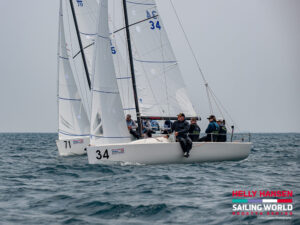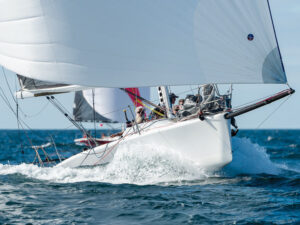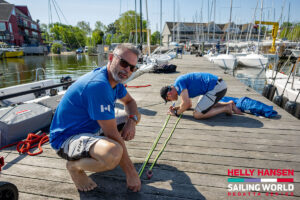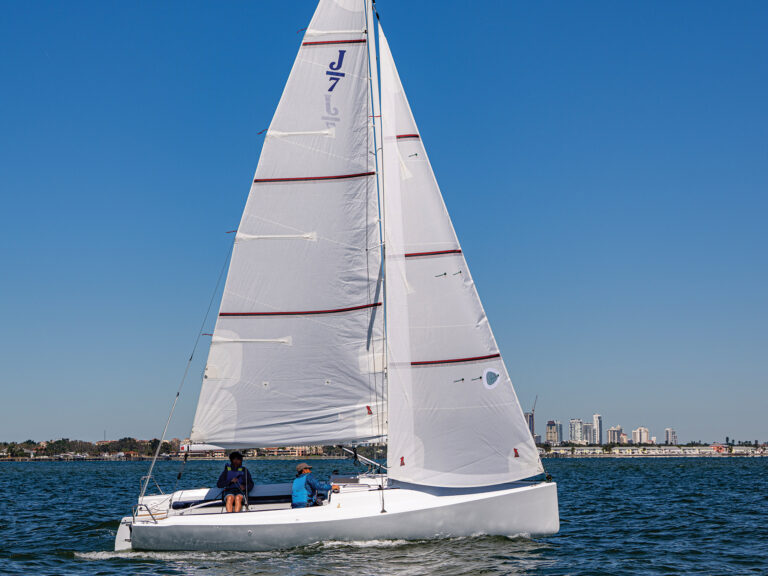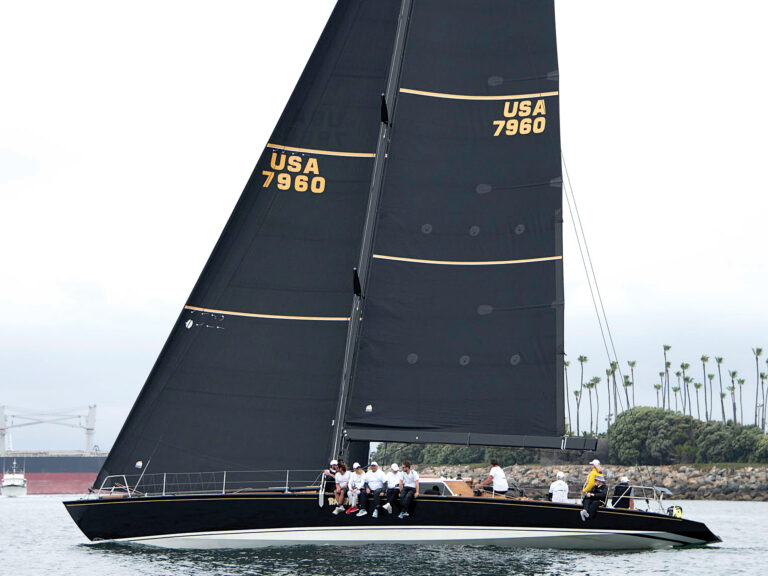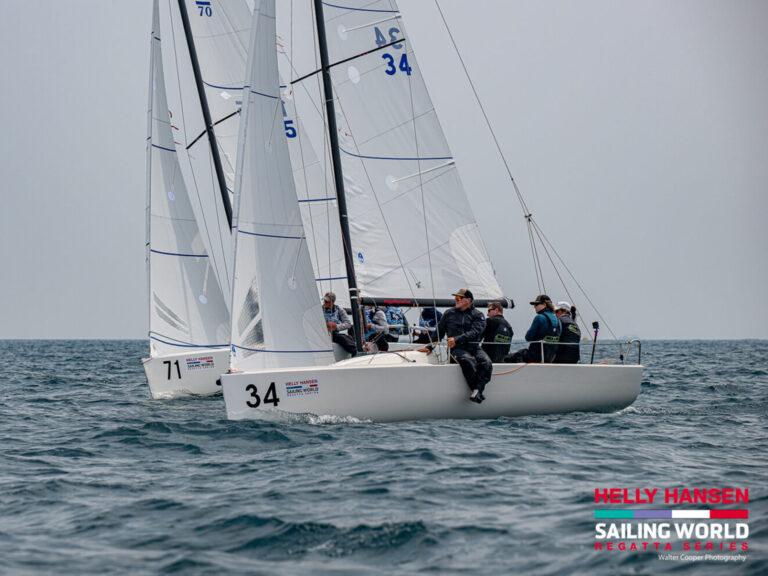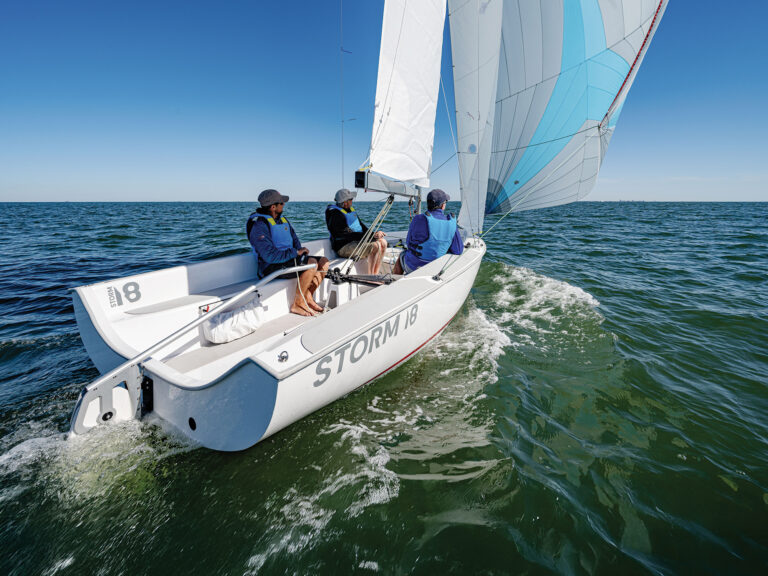In the first two articles in this series we discussed situations in which a boat that had an inside overlap when she reached the zone was entitled to mark-room under the first sentence of Rule 18.2(b). That’s half the story. There are also three parts of Rule 18 that require one boat to give another mark-room when the boats are not overlapped when they reach the zone. They are the second sentence of Rule 18.2(b), and Rules 18.2(a) and 18.3(b).
The second sentence of Rule 18.2(b) states that a boat that reaches the zone while she is clear ahead of another boat is entitled to mark-room from the boat that is clear astern. This sentence rarely leads to protests because, even when the boat clear astern is very close to the boat clear ahead, the boat astern will begin her rounding wide of the mark and try to end up just inside the boat ahead. There are, however, two situations at leeward marks that often result in protests. They’re shown in the diagrams. Let’s assume the leeward mark must be left to port and the boats are Lasers sailing in moderate wind and smooth water directly downwind as they approach the zone.
In the first diagram Joe, on port tack, reaches the zone a few feet clear ahead of Inga, who is on starboard. Inga blankets Joe, and just before Position 2 Inga has to change course to avoid hitting Joe’s stern. Inga heads up slightly and hails, “Protest, Joe! You’re on port tack, I’m on starboard, and you didn’t keep clear.” Joe keeps sailing without taking a penalty.
Here’s how the rules apply to this incident. Inga is required to give Joe mark-room, and that obligation continues when Inga later becomes overlapped with Joe (see Rule 18.2(c)). Mark-room for Joe includes room for him to sail directly to a position close alongside the mark with the mark on his port side. At Position 2, Inga luffed because she needed to take action to avoid colliding with Joe. At that moment, Joe broke Rule 10 by failing to keep clear of Inga, a starboard-tack boat. However, Joe was sailing within the mark-room to which he was entitled. Therefore, under Rule 21(a), he is exonerated for breaking Rule 10. Rule 14 always applies, but there was no contact and so neither boat broke it. Neither boat should be penalized.
In the second diagram, at Position 1 when Laura reaches the zone, she and Ken are in the same positions that Joe and Inga were in when Joe reached the zone. Then, just as in the Joe-Inga incident, Ken blankets Laura and has to change course to avoid hitting her stern. But there the similarity between these two incidents ends. Ken bears off and establishes an inside overlap on Laura, and both boats protest. Ken protests Laura for breaking Rule 10. Laura protests Ken because after Position 2 he was not giving her room to sail to the mark. If Laura had headed up to a course that would take her to the mark, she would have collided with Ken. Therefore, she claims that at Position 2 Ken was not giving her mark-room as he was required to do by Rules 18.2(b) and (c).
The rules apply quite differently to Ken and Laura than they did to Joe and Inga. At position 2, Laura broke Rule 10. At that time she was taking more space than she needed to sail to the mark promptly in a seamanlike way. Therefore, when Laura broke Rule 10 she was not sailing “within” the mark-room to which she was entitled. As a result, she is not exonerated for breaking Rule 10 under Rule 21(a) and should be disqualified. What’s more, at Position 2 Ken was still required to give Laura mark-room, and he was not doing so. If she had luffed up to sail to the mark, as she was entitled to do, Ken would have likely collided with her, and she would have broken Rule 14. Therefore, Ken should also be disqualified because at position 2 he was breaking Rules 18.2(b) and (c) by not giving Laura room to sail to the mark.
There’s an important principle illustrated here: When a boat is required to give you mark-room and, at the same time, you are required to keep clear of that boat, you should sail “within” the mark-room to which you are entitled. If you do not, you lose the protection of Rule 21(a). While you are the keep-clear boat you are protected by Rule 21(a) only when you are “sailing within the … mark-room to which [you] are entitled” under Rule 18.2(b). You should only make a tactical approach and rounding of the mark if you’re the right-of-way boat or if you are so far from the other boat that there is no risk of breaking a rule.
So far, we have analyzed how the rules work when one of Rule 18.2(b)’s two sentences applies. However, there is often doubt, most often at the leeward mark, about which sentence applies. Consider this situation: You and Larry are approaching the zone around the leeward mark. Larry has been clear astern, but he has been gaining on you and almost has an inside overlap. When you think your bow is three lengths from the mark, you look back at Larry’s spinnaker, decide that he doesn’t have an overlap, and hail, “No overlap!” Larry sees the situation differently. He hails, “Overlap! Give me mark-room.” You’ve got a problem. Of course, you could also have a very similar problem if you had been overlapped outside Larry for some time and, just before you reach the zone, you believe you’ve pulled clear ahead, but he believes that he still has an inside overlap.
There is a rule that clearly deals with these two problems. It is Rule 18.2(d): “If there is reasonable doubt that a boat obtained or broke an overlap in time, it shall be presumed that she did not.” So, if it was obvious on the approach to the zone that you were clear ahead of Larry, then, if there is doubt that he obtained an inside overlap in time, “it shall be presumed” that he did not. However, if it was clear on the approach to the zone that Larry was overlapped inside you, then if there is doubt that you broke that overlap in time, “it shall be presumed” that you did not.
Who or what is the “it” that is required to “do the presuming” here? On the water, the two boats involved should “do the presuming” and use Rule 18.2(d) to resolve their problem. So the boat that claimed the change of status (either from clear ahead/clear astern to overlapped, or from overlapped to clear ahead/clear astern) should drop her claim. If the incident gets to the protest room, then the protest committee is required to do the presuming. The committee will take evidence to determine the status of the overlap at what umpires call “the last point of certainty.” That is, shortly before the boats reached the zone, were they clearly overlapped or clearly not overlapped? Then the committee is required to decide the protest using the presumption in Rule 18.2(d).
This article first appeared in the March/April 2014 issue of Sailing World. Click here to read the other articles in the Mark-Room series. Click here to read more about the Racing Rules of Sailing.



